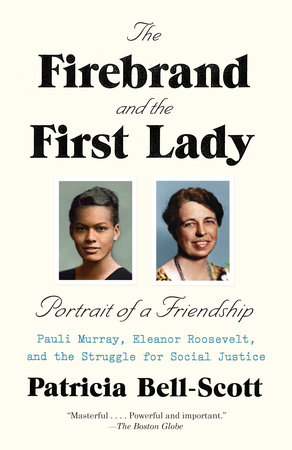The Firebrand and the First Lady Reader’s Guide
By Patricia Bell-Scott


1. Pauli Murray was 24 and Eleanor Roosevelt was 49 when their paths first crossed in 1934 at Camp Tera. What aspects of the camp bore ER’s imprint? Why did Murray have fond memories of the camp positive, despite her difficulties with the camp director who expelled her?
2. Pauli Murray’s initial letters to Franklin and Eleanor Roosevelt were protest statements against the whites-only admission policy of the University of North Carolina, the humiliation of unemployment, and a segregated benefit at the Keith Theatre in Washington, D.C. How did Murray’s letters influence ER’s response to racial discrimination? How did ER’s response affect Murray?
3. How did the University of North Carolina’s rejection of Murray’s application for admission to the graduate school, her arrest in Petersburg, Virginia, for refusing to move to the black section of a Greyhound bus, and her work with the Workers Defense League as field secretary for the Odell Waller campaign impact her life?
4. The NAACP twice refused to handle the appeals for discrimination cases in which Pauli Murray was a plaintiff. Why?
5. During the course of their long friendship, Eleanor Roosevelt shared Pauli Murray’s opinions with Franklin Roosevelt, members of his administration, opinion-makers, and the readers of “My Day.” Identify one of the issues that seemed closest to ER’s heart?
6. Murray suspected that the prejudice and discrimination she faced because of her race, sex, and sexuality thwarted her professional advancement and contributed to her marginality in the historical record? What do you think?
7.Murray was a self-described individualist and temperamentally shy. She also had a thyroid disorder that caused mood swings. How might these factors have frustrated her relationships and ambition?
8. How did the early life experiences of Pauli Murray and Eleanor Roosevelt influence the kind of leaders they became?
9. The campaign to save the life of Odell Waller was unsuccessful. However, it fostered an alliance between Pauli Murray and Eleanor Roosevelt that became a turning point in their budding friendship. What aspects of the case drew them together, and why? Do you see any parallel between the Odell Waller case and the contemporary debate about the interrelationship of race, class, voting rights, and criminal justice?
10. Both Pauli Murray and ER were women of faith. How did this influenced their actions?
11. Pauli Murray said she went to Howard University Law School intent on becoming a civil rights lawyer and she graduated “unabashed feminist as well.” How did the law school experience influence her thinking?
12. Do you think that the friendship between Pauli Murray and Eleanor Roosevelt changed their political views? Did Murray ever move toward the center? Did Eleanor Roosevelt move left?
13. Pauli Murray coined the term “Jane Crow.” Explain what she meant by this.
14. The student protests Pauli Murray and her fellow Howardites mounted to desegregate Washington, D.C. restaurants were a model for the lunch counter sit-ins of the 1960s. What common strategies did the two groups share?
15. Why and how did Eleanor Roosevelt’s support of African Americans, especially during World War II, create tension in the White House, resentment from the administration’s enemies, and admiration from blacks and progressives?
16. The author has found no correspondence in which Murray discussed her sexuality with Eleanor Roosevelt. Do you think ER may have figured this out? If so, why?
17. For what reasons did Pauli Murray come to regard Eleanor Roosevelt as quasi-kin? How did ER demonstrate her fondness and concern for Murray? And how did Murray demonstrate her fondness and concern for ER?
18. Explain the intellectual and personal connections Murray had to the argument and people involved in the U.S. Supreme Court’s historic Brown decision.
19. How did McCarthyism touch Pauli Murray and her friends?
20. On what issues did Pauli Murray and Eleanor Roosevelt agree and disagree regarding the 1956 Adlai Stevenson presidential campaign?
21. What fueled the writing of Pauli Murray’s family memoir Proud Shoes?
22. What were the benefits, as well as the challenges Murray faced as a junior associate at the firm of Paul, Weiss, Rifkind, Wharton and Garrison?
23. What made Pauli Murray’s partnership with Irene Barlow the most satisfying relationship of her adult life?
24. How did Murray’s expectations of Africa measure up against her experience?
25. How did Eleanor Roosevelt’s response to the student movement of the early 1960s compare to her response to youth activists in the 1930s and 1940s when she was first lady?
26. Did Pauli Murray and Eleanor Roosevelt differ in their view of John F. Kennedy?
27. Eleanor Roosevelt died in November 1962, four months after Murray’s last visit to Val-Kill. Describe how Murray sought to honor her friendship with ER and keep the first lady’s legacy alive until her own death in July 1985.
28. What is Pauli Murray’s lasting contribution to the struggle for women’s equality?
29. The file the FBI created on Pauli Murray contained a number of accusations about her affiliations and her character? How were they used against her?
30. Why did Pauli Murray become a priest and how did she define her mission?
Just for joining you’ll get personalized recommendations on your dashboard daily and features only for members.
Find Out More Join Now Sign In